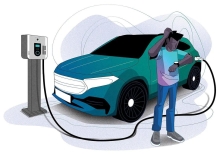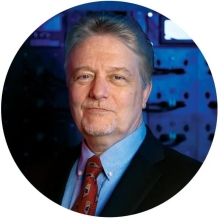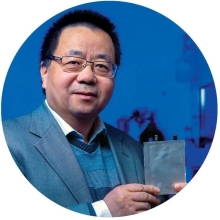
Via Maryland Today / By Chris Carroll
UMD Researchers Are Powering Up EV Batteries to Save the Planet
WESTWARD-BOUND PIONEERS of an earlier era packed their wagons, hitched up the oxen and set out. Before his own trailblazing cross-country journey, Mark Eakin first tested his wheels at a D.C.-area drag strip.
There, his Ford F-150 Lightning—a battery-powered version of America’s most popular vehicle—posted acceleration times that would rival a Ferrari’s, while emitting no greenhouse gases. The “frunk,” however, is Conestoga-esque in the storage gained from ditching the traditional internal combustion engine.
His new truck seemed the perfect vehicle to help Eakin, a retired coral reef scientist for the federal government and occasional University of Maryland research collaborator, forge a new Oregon Trail of climate-friendly travel. In early 2023, he and his wife, June, became the first people—as far as anyone in the electric vehicle enthusiast community can tell, anyway—to pull a travel trailer coast to coast and back with an EV.
Make that the almost-perfect vehicle. The trailer’s weight and wind drag shrank the truck’s range, requiring half-hour stops at fast-charging stations about every 110 miles. Those breaks became all-day affairs in remote areas like rural Idaho and the Texas plains with scarce charging infrastructure, where the truck had to sip electrons from regular outlets.
None of this surprised the couple, who planned on short hops between friends, family and sightseeing. “It was a bit of an experiment,” Eakin said. “The idea wasn’t to get anywhere as fast as possible.”
Beyond committed environmentalists and hardy early adopters, the rest of the nation may be less tolerant of battery-related EV inconveniences. At least that’s the fear of government agencies and nonprofits behind a sweeping plan to “decarbonize” the U.S. economy to save the planet from global warming—and it’s why UMD researchers are at the forefront of developing EVs that can charge faster than you can fill a gas tank, have the range to cruise to the horizon and beyond without a stop, and boast unprecedented safety and performance in even the most extreme conditions.
The clock is ticking. Limiting U.S. greenhouse gas emissions to head off the worst effects of climate change means getting as many butts in electric vehicle seats as possible and moving to a power grid based on renewable energy sources, including wind, solar and hydrogen fuel.
“We have to accelerate the societal shift to electric vehicles,” said Distinguished University Professor Eric Wachsman, a globally recognized expert in next-gen battery technologies and director of the Maryland Energy Innovation Institute. “And that means you have to overcome the resistance some people have to these kinds of vehicles.”
Maintaining Momentum?
EVs in 2023 accounted for 7.6% of the U.S. new vehicle market, up from 5.9% in 2022, but beyond the coasts and big cities, the lure of swoopy Teslas, burly Rivian trucks and an increasing selection of cars from traditional manufacturers is in question.
For instance, a January 2024 Deloitte survey of 27,000 global consumers showed concerns about charging speeds and vehicle range were causing people to avoid EV purchases. At almost the same time, Ford slashed F-150 Lightning production by two-thirds, citing weak demand, while other manufacturers also retrenched with plans to sell fewer EVs and more traditional vehicles.
What’s needed, say UMD researchers, is a self-perpetuating virtuous circle where every advance expands the user base, leading to greater support and infrastructure, and making EVs appealing to ever-broader swaths of society. That will include marginalized and low-income groups who bear much of the brunt of pollutants from conventional vehicles, and who are most vulnerable to climate-related harm as fossil fuel use continues to heat up the earth.
Beyond the upper-income groups that make up most of the EV market today, switching to an EV in 2024 is a tall, if not impossible, order, contributing to growing tech disparities and hampering society’s ability to head off environmental catastrophe.
“We shouldn’t be naïve about how hard it is for people from disadvantaged groups to enter these kinds of markets,” said Deb Niemeier, Clark Distinguished Chair in the Department of Civil and Environmental Engineering (who is not part of the A. James Clark School of Engineering’s battery design efforts). “First and foremost, you have to have affordability and there has to be a viable used car market, and public charging must be available in places where it barely exists now.”
To address such challenges, UMD battery researchers are among the most active in the nation working to meet the performance requirements of the EVs4ALL program overseen by the Advanced Research Projects Agency-Energy (ARPA-E), a federal agency that deals in cutting-edge energy projects. To those ends, Wachsman and others plan to bring batteries to market in coming years that last through many thousands of charge cycles, enabling used car markets; batteries that use cheaper, more readily available components than traditional ones like lithium; batteries that charge up in minutes rather than hours, even in low temperatures that stymie current technology.
“At UMD we have a large number of faculty and students on these projects compared with other academic institutions,” said Paul Albertus, an assistant professor of chemical and biomolecular engineering who in his previous job was the program manager for over $60 million of mostly battery projects for ARPA-E. “What really sets us apart is that we have research groups working on so many of these different aspects—solid electrolytes, liquid electrolytes, people doing basic science and people doing technological innovation—and that portfolio of work is complementary.”
Replacing the Batteries
Current lithium rechargeables have fueled technological leaps in mobile computing, medical devices and e-bikes and -scooters; they’re tucked into an ever-increasing number of our cars and light trucks—from an International Energy Agency figure of around 26 million EVs globally in 2022 to recent Bloomberg forecasts of 77 million next year. More than 200 million electric vehicles are expected to be on the road worldwide by the end of the decade—but powered by what?
As anyone knows who’s seen surveillance videos of exploding scooters and terrorized vape pen users dropping and fleeing their devices, or discovered their phone bulging and nonfunctional with a swollen battery, lithium-ion cells have a dark side that stems from their chemistry. They use
a flammable liquid electrolyte, the part of the battery that carries electric current between the positively and negatively charged internal components of cells, made of lithium salts dissolved in an organic solvent.
“Liquid lithium electrolytes are very volatile. If you have a short or damage to the battery, you can have what’s called a thermal runaway reaction where the battery’s energy heats up the battery uncontrollably and can start a fire,” said Professor Chunsheng Wang, director of UMD’s Center for Research in Extreme Batteries—a collaboration with the U.S. Army Research Lab—and like Wachsman, a faculty member in chemical and biomolecular engineering as well as in materials science and engineering.
(For perspective, EVs don’t burn often, although they get a lot of press when they do. “They’re very safe, safer than a typical car, in fact,” said Ron Kaltenbaugh, president of the Electric Vehicle Association of Greater Washington. His claim echoes recent data from both Tesla and an Australian government study showing that EV batteries, frequently bundles of hundreds of smaller battery cells, are an order of magnitude less likely to ignite than petroleum-powered engines. “But they can be pretty hard to put out” once fully engulfed, Kaltenbaugh said.)
Managing conventional lithium-ion batteries’ safety issues comes at a heavy cost—literally. Their various added layers and separators, along with extra circuitry and other protection measures on the outside, make current EV battery systems far bulkier and less “energy-dense” than they would be with inherently safer chemistry.
“Every layer of material you add to the battery is that much less energy the battery can hold,” Wachsman (left) said.
According to ARPA-E, the current generation of lithium-ion batteries suffers from “performance limitations that incremental progress cannot address,” hampering a full transition away from the 1.7 billion conventional light vehicles on the road globally, along with a similar number of heavy trucks, buses and the like.
A new path lies in solid-state battery technology. It replaces lithium-ion batteries’ problematic liquid electrolytes with safer, nonflammable alternatives. This is at the heart of research in the Maryland Energy Innovation Institute, which in recent years has helped launch dozens of companies, filed for well over 100 patents and secured around $150 million in funding for the startups, several of which focus on technology directly applicable to vehicles.
Wachsman’s solid-state design replaces the liquid electrolyte with a rigid ceramic known as garnet that conducts ions about as well as a conventional lithium-ion electrolyte, while being nonflammable and tough enough to endure thousands of charges. The technology is being developed by Wachsman’s spinoff company, Ion Storage Systems, with the help of recent $40 million investment rounds.
In June, the company received a $20 million Department of Energy grant, which it will combine with another $20 million in private matching funds to dramatically accelerate the commercialization of safe, energy-dense and fast-charging batteries.
Access Issues
As the Eakins wended their way across the country, the frequent stops for fast charging along major interstates weren’t what bothered them. “People talk about the 400-mile battery—who’s got a 400-mile bladder?” Mark Eakin said.
The lack of charging spots in the nation’s interior was what made it impractical to visit the house in the Texas Panhandle where Mark’s grandparents had lived; the Eakins also had to carefully manage their approach to Big Bend National Park in the western end of the state to avail themselves of the few available charging opportunities and driving slower than normal to extend their range along certain stretches of interstate.
Issues of vehicle range, charging rates and infrastructure are interrelated; one way to incentivize building more charging infrastructure is to make more people want—and buy—electric cars by addressing the issues in a holistic manner rather than individually. UMD’s battery experts plan to do that in part by rendering obsolete one of the loudest complaints against EVs: They take too long to charge.
While “slow” is relative, so-called Level 1 charging with regular outlets is painfully poky, adding less than five miles of driving range for every hour plugged in. Level 2, available at around 54,000 public charging stations in the U.S. and at many EV drivers’ homes, uses 240-volt power to add 20 or more miles of range an hour. Level 3, known as DC fast charging, or “Supercharging” in the Tesla universe, can boost a car’s battery to 80% in 20 minutes to an hour. The catch? Only about 9,400 such charging stations exist in the United States, according to research by UMD’s Center for Global Sustainability (CGS), and per mile they rival gasoline in cost, negating one of the draws of EVs.
That scarcity leaves vast swaths of the population without a practical way to drive an EV, contributing to sluggish sales even as average prices have been plummeting. CGS’s work found that access to charging is far from equal in U.S. society, with members of racial and ethnic minority groups and low-income people on average traveling farther to find an EV charger, said Jiehong Lou, a CGS assistant research professor who studies equitable access to EV technology. Likewise, African Americans have less potential to reap the cost savings of home charging because of significantly lower homeownership rates than white people, she said.
To be broadly popular, EVs can’t require a hobbyist level of commitment and a spacious suburban home, Wachsman said.
“Someone like me can drive home at night, close the garage door when it’s cold outside (because EVs don’t charge well in the cold), plug into a Level 2 charger, and you’re ready to drive the next day,” said Wachsman, who’s driven a Tesla since 2013. “But there are a lot of people who live in apartments, live in a city environment, who just don’t have home charging. Then it gets a lot harder to drive an EV.”
In a Flash
Today’s half-hour fast charging sessions offer drivers a chance to play a few rounds of Candy Crush and read emails, welcome or not. In the future, they’ll race to squeegee their windshield before the charge is finished.
In recent work, Wachsman showed that by modifying the composition of his patented ceramic architecture, he could charge or discharge lithium metal batteries at rates up to 100 milliamperes per cubic centimeter, enabling EV battery charging in about 90 seconds and exceeding the U.S. Department of Energy’s fast-charging goal for EVs by a factor of 10. The new approach would also result in batteries with a lifespan far longer than typical cars need.
Meanwhile, Wang and colleagues showed a way to stop “dendrites,” tiny branch-like structures that grow in the microscopic confines of an advanced solid-state cell during fast charging and other intense usage, causing short circuits. A new interlayer in the battery can stop lithium dendrites that develop in the battery’s negative electrode, piercing the solid electrolyte and destroying the battery.
Wang (right) also presented battery technology recently that overcomes another major hurdle for lithium-ion batteries: rapidly declining efficiency and chargeability as the temperature gets closer to the freezing point. In 2023, he demonstrated a battery that operates down to minus 60 degrees Celsius. He’s commercializing the technology through his battery spinoff company, Wh-Power.
In research not directly related to EVs, Wang has produced batteries that use saltwater as an electrolyte and with previously unheard-of voltage levels; he’s working to boost the energy a bit higher to create batteries that are intrinsically safe and cheap—“just go get some water from the ocean,” he jokes—that can be used to store excess wind or solar energy generated on a renewable power grid. Such batteries could provide carbon-free vehicle charging in the most remote locations.
UMD engineers and chemists are working on a wide range of other battery technology as well that could one day power electric vehicles and other technology of the future. Some focus on finding “earth-abundant” replacements for lithium, which is toxic, relatively rare and vulnerable to supply line delays caused by geopolitical disruptions. Another line of research, led by Distinguished University Professor Gary Rubloff in materials science and engineering, uses nanotechnology to precisely design microbatteries with huge power output for their size; they could be constructed much like microprocessors on outdated assembly lines for silicon chips.
“The more of these problems we solve, the more electric vehicles people will be driving, and the better for the environment,” Wang said.
Accelerating Acceptance
On a back road near Frederick, Md., Kaltenbaugh, head of the D.C. EV owners’ network, pressed the accelerator on his Tesla Model 3; the dual motors kick in almost silently, squishing a passenger back into his seat as barns and a farm animal or two fly by.
“We’re still in ‘Chill’ mode,” he pointed out, indicating the possibility of several higher levels of squish. Although Kaltenbaugh said he rarely tests the car’s performance potential, the acceleration has at least once helped him avoid a potential collision with an erratic driver while he was merging onto a highway.
A massive dashboard screen displays miles remaining on his battery—about 170—and when Kaltenbaugh pulled over, he activates a map showing every available charger in the region. It looks like a cornucopia, but the density of options thins toward the edges.
“Electric vehicle technology is never going to ‘get there’ if that means a stage where it’s fully developed,” said Kaltenbaugh, whose family has transitioned entirely to battery-powered cars. An avid skier, he’s seen the impact of climate change in mountain environments around the country, where subtle temperature changes can have outsize impacts on snowpacks.
“It’s going to keep developing. It’s a matter of whether the price-to-performance ratio works for you. If it does, you get an EV.”
For those who can afford a new car now and have a place to charge it, EVs’ efficiency and performance advantages combined with lower regular maintenance requirements already make them a logical choice over fossil fuel-powered vehicles, said Wachsman. With their revolutionary battery advances, Maryland researchers plan to soon push it over the hump for everyone else.







